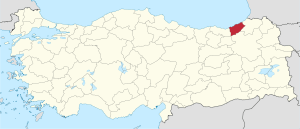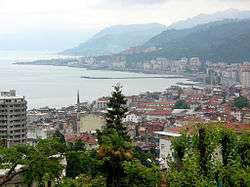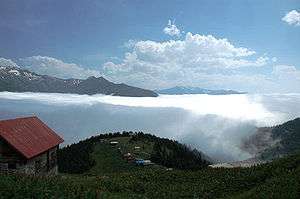Rize Province
| Rize Province Rize ili | |
|---|---|
| Province of Turkey | |
 Location of Rize Province in Turkey | |
| Country | Turkey |
| Region | East Black Sea |
| Subregion | Trabzon |
| Government | |
| • Electoral district | Rize |
| Area | |
| • Total | 3,920 km2 (1,510 sq mi) |
| Population (2010-12-31)[1] | |
| • Total | 319,637 |
| • Density | 82/km2 (210/sq mi) |
| Area code(s) | 0464 |
| Vehicle registration | 53 |
Rize Province (Turkish: Rize ili) is a province of north-east Turkey, on the eastern Black Sea coast between Trabzon and Artvin. The province of Erzurum is to the south. it was formerly known as Lazistan, the designation of the term of Lazistan was officially banned in 1926, by Kemalists.[2] Its capital is the city of Rize. The province is home to Laz,Hemshin and Turkish people communities.
Etymology
The name comes from Greek ρίζα (riza), meaning "mountain slopes".[3] The Georgian name is Rize (რიზე), Laz name is Rizini (რიზინი) and the Armenian name is Rize (Ռիզե).
Geography
Rize is located between the Pontic Mountains and the Black Sea. It is considered to be the "wettest" corner of Turkey and is the country's main tea producing region. In addition to tea, the region is also known for growing kiwi fruit. The province is largely rural and very scenic, containing many mountain valleys and elevated yaylas (meadows). The district of Çamlıhemşin is one of Turkey's most popular venues for trekking and outdoor holidays. Roads are scarce in some of the more remote regions, so electrical powered cable cars have been installed to transport people and supplies into the mountains.Summers are cool (July average 22 °C) and winters are mild (January average 7 °C) with high levels of precipation all year long.
The new Black Sea coast road has made Rize more accessible, but has drawn criticism for its negative effect on the region's wildlife. Since the early 2000s, Rize has seen an increase in visitors from outside the province, particularly tourist from urban areas. This increase in tourism has raised concerns among locals that the traditional way of life and the unblemished character of the natural surroundings is being endangered. The provincial governor, Enver Salihoglu (as of 2005) has stated his opposition to the expansion of the road network and has advocated a commercial focus on beekeeping, trout farming, and the growing of organic teas.[4]
Native plants include the Cherry Laurel (Turkish: taflan or karayemiş), the fruit of which is an edible small dark plum that leaves a dark stain on the mouth and teeth. In addition, the Bilberry, which are now being actively cultivated, can be found growing the region. Rize is traversed by the northeasterly line of equal latitude and longitude.
Mountains

Notable mountains[5]
Rivers
From east to the west
- Fındıklı Deresi
- Büyükdere
- Pazar Suyu
- Karadere
- İyidere
Geology
Part of the Pontic Mountains (Eastern Black Sea Mts.), Rize was formed in the Palaeozoic period. Valleys first appeared during the Cretaceous period and have since expanded due to erosion.
Climate
The region's climate is characterized by relatively high temperatures and evenly distributed precipitation throughout the year. The Köppen Climate Classification subtype for this climate is Cfa (Humid Subtropical Climate).[6]
History
Ancient history
We have little information as to the prehistory of this region, which being covered in thick forest is difficult to excavate and reveals little. Qulha or Kolkhis (Colchis) which existed from the c. 13th to the 1st centuries BC is regarded as an early ethnically Georgian polity in this area; The Urartian King Sardur II (764–735) led several campaigns against Colchis around 750–741 BC, significantly weakening and exposing it to the attacks of northern tribes.
Then in 714 BC a tribe of Cimmerians came to settle by the Çoruh River, fleeing as their homeland in the Caucasus was overrun by the Saka branch of the Scythians. The Cimmerians spread throughout Anatolia and still today there are many places named Kemer as a record of their presence, including some villages in Rize. The Saka meanwhile spread westwards into eastern Europe and in 680 BC defeated the last of the Cimmerians in Georgia, but they themselves were overturned by the Medes, who murdered the Saka King Madova in 626 BC.
Antiquity
According to Pliny the Elder, from 670 BC onwards the Aegean Ancient Greek community of Miletus established a series of trading posts along the Black Sea coast; one of these was Rize. in the mid-6th century BC The tribes living in the southern Colchis (Tibareni, Mossynoeci, Macrones, Moschi, and Marres) were incorporated into the 19th Satrapy of Persia. later the Persian armies were defeated by Alexander the Great. Following the death of Alexander a number of separate kingdoms were established in Anatolia including Bithynia and Cappadoccia and in this corner of the eastern Black Sea, Pontus. Rize was brought into the Kingdom of Pontus by Pharnaces in 180 BC.
The kingdom was absorbed into the Roman Empire between 10 AD and 395 AD, when it passed to the Byzantines. By this time writers including Pliny and the Roman adventurer Arrian were describing the inhabitants as Laz.
Medieval
During the whole medieval period, the region was under Byzantine control, and was largely populated by Greeks. The high country above Rize, however, was in flux and as late as 626 AD, when a tribe of Scythians, having been displaced by Persians further east, came to settle in the area that is today's district of Hemşin.
A short period of Turkish domination in the region took part in the late 11th century, following the defeat of the Byzantines at the Battle of Malazgirt, and the Çoruh River. It was then incorporated into one of the Anatolian beyliks following the defeat of the Georgian Kingdom at the siege of Posof in 1080.
Large numbers of Turks coming to settle along the coast, including a large influx of Kipchak Turks. But it was still mainly a Greek speaking region. The area was recaptured by the Byzantines in 1098 during the Crusades and later following the sack of Constantinople in the Fourth Crusade of 1204, the Byzantine Imperial family itself removed to nearby Trabzon establishing the Empire of Trebizond, of which Rize was part.
However, the area had been largely settled by Turks and this community remained, the Byzantines merely keeping a base in Rize.
The Ottoman era

The Turks in the area were from various tribes in Anatolia, all under the Seljuk umbrella but with varying degrees of loyalty and contentment; there were numerous rebellions and uprisings. This era ended when the Empire of Trebizond began paying tribute to the Ottoman Empire in 1456 and then the Ottoman army led by Sultan Mehmet II entered Trabzon in 1461. Rize fell in 1470.
From the late-17th century onwards, the Ottoman administration built many elegant bridges across the Fırtına River and its tributaries.
The province was a site of battles between Ottoman and Russian armies during Caucasus Campaign of World War I and was occupied by the Russian forces in 1916-1918. It was returned to the Ottomans with the Treaty of Brest-Litovsk in 1918.
From 1924 onwards, Rize has been a province of the Republic of Turkey. Until tea was planted here in the 1940s this was a poor area at the far end of the country, with only the Soviet Union beyond the Iron Curtain. Many generations of Rize people left to look for jobs in Istanbul or overseas.
Life in Rize today
The city of Rize itself is a quiet country town on the coast, on a narrow strip of flat land between the mountains and the sea. Today the area is wealthier although there is a marked difference between the lifestyle of the people in the relatively wealthy city of Rize and those in the remote villages where wooden houses perch on the steep mountainside with the rain beating down. The province is known in Turkey for the production of Rize Tea.
Culture
Cuisine

Traditional cuisine in the city quite rich and the anchovy forms the basic for many of the dishes peculiar to the region. Soups, salads, pilafs and even desserts are made of anchovy. Some of the local dishes are hamsi buğulama (boiled anchovy), hamsi stew, and kamsi köfte (anchovy meatballs). Lahana çorbası (cabbage soup), muhlama (made of cheese, cornmeal and butter) and pides (pita bread topped with various fillings) are also other local delicacies)[7]
Folk dances and traditional costumes
Folk dancers perform horon energetically when it is acoompanied by kemenche. However this folk dance can also be accompanied by tulum or kaval. Folk dancers wear traditional costumes while performing horon. Men wear shirt, vest, jacket, zipka (pants made of wool and gathered at knees) and black boots. On their jackets are silver embroideries, amulets hemayils with religion expressions put inside these small silver containers to br protected against evil's eye. On the other hand, women dancers wear colorful dresses and traditional hand painted head scarves including various motifs.[8]
Handicrafts
Rize offers a rich variety of traditional handicrafts and handmade souvenirs to visitors. Some of them: copper works, wicker baskets, churns, socks, shoulder bag, spoon made of boxwood
Districts
Rize province is divided into 12 districts (capital district in bold):
- Ardeşen
- Çamlıhemşin
- Çayeli
- Derepazarı
- Fındıklı
- Güneysu
- Hemşin
- İkizdere
- İyidere
- Kalkandere
- Pazar
- Rize
Places of interest

Rize is a province of great natural beauty, sites of particular interest include:
- Ayder - A yayla (high meadow) area with hot springs, hotels and restaurants, and from here you can climb up to higher and more remote meadows and villages.
- Çamlık - riverside area of forest park
- Fırtına Vadisi - the valley is now a protected site of natural beauty
- Ovit - mountain pass on the Erzurum road in Ikizdere, 2,640 metres (8,660 ft), forest and mountain viewpoint
- The village and waterfall of Palovit, high in the mountains.
- Avup Dağı, the mountain between Rize and Çamlıhemşin, between Fırtına Deresı and Ortaköy Deresi. There are four Byzantine castles perched high on rocks on the mountainside including;
- Kale-i Balâ and Zilkale
Other buildings of note include:
- The watch tower, Kız Kalesi on the sea front in Pazar.
See also
References
- ↑ Turkish Statistical Institute, MS Excel document – Population of province/district centers and towns/villages and population growth rate by provinces
- ↑ Thys-Şenocak, Lucienne. Ottoman Women Builders. Aldershot, England: Ashgate, 2006. Print.
- ↑ Rize article from Özhan Öztürk, Encyclopedia of Black Sea (Karadeniz Ansiklopedik Sözlük), 2005
- ↑ "How Green Is Their Valley" The Economist. 27 August – 2 September 2005
- ↑ Öztürk, Özhan. "Rize". Kara Lahana.
- ↑ Climate Summary for Rize Province
- ↑ Traditional cuisine
- ↑ People of Black Sea Region of Turkey
External links
| Wikimedia Commons has media related to Rize Province. |
- (Turkish) Rize governor's official website
- (Turkish) Rize municipality's official website
- (English) Rize weather forecast information
- (Turkish) Rize Tourism Guide
- Culture and travel Trabzon and Rize
- Rize photo gallery
Coordinates: 40°55′54″N 40°50′52″E / 40.93167°N 40.84778°E
